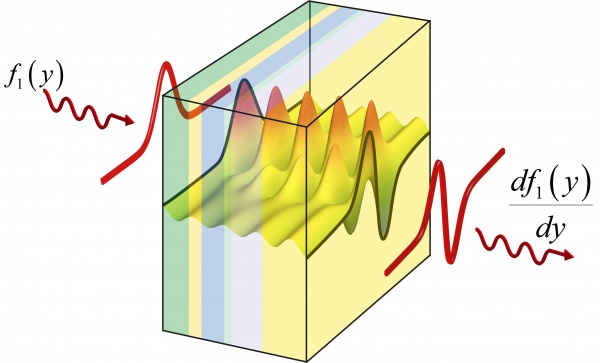A theoretical metamaterial that acts as an analog computer
Computational metamaterials could almost instantly perform certain complex mathematical operations
January 12, 2014

The curve of the incoming wave’s profile is transformed into that curve’s derivative (credit: Alexandre Silva)
A light wave, when described in terms of space and time, has a profile in space that can be thought of as a curve on a Cartesian (x,y) coordinate system.
The theoretical metamaterial can perform a specific mathematical operation on that wave’s profile, such as finding its first derivative (instantaneous rate of change) as the light wave passes through the material.
Essentially, shining a light wave on one side of such a material would result in that wave profile’s derivative exiting the other side. Metamaterials capable of other calculus operations, such as integration and convolution, could also be produced.
Viewing and manipulating this type of light-wave “profile” is an everyday occurrence for applications like image processing, though it is typically done after the light wave has been converted to electronic signals in the form of digital information. The researchers’ proposed computational metamaterials could almost instantly perform such operations on the original wave, such as the light coming in through the lens of a camera, without conversion to electronic signals.
Both mechanical and electronic analog computers were particularly suited to calculating large tables of information. Where the paper-and-pencil method would require tedious and repetitious steps performed on each of the table’s elements, with each step prone to human error, analog computers could perform those steps in parallel, producing the results all at once.
“Compared to digital computers, these analog computers were bulky, power hungry, and slow,“ said Nader Engheta, the H. Nedwill Ramsey professor of Electrical and Systems Engineering in Penn’s School of Engineering and Applied Science. “But by applying the concepts behind them to optical metamaterials, one day we might be able to make them at micro- and nanoscale sizes, and operate them at nearly speed of light using little power.”
“The thickness of our structures can be comparable with the optical wave length or even smaller,” said Vincenzo Galdi of the University of Sannio. “Implementing similar operations with conventional optical systems, such as lenses and filters, would require much thicker structures.”
(¯`*• Global Source and/or more resources at http://goo.gl/zvSV7 │ www.Future-Observatory.blogspot.com and on LinkeIn Group's "Becoming Aware of the Futures" at http://goo.gl/8qKBbK │ @SciCzar │ Point of Contact: www.linkedin.com/in/AndresAgostini
 Washington
Washington